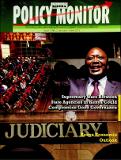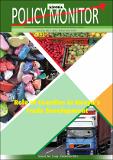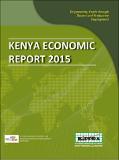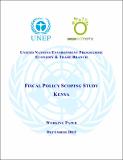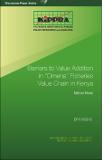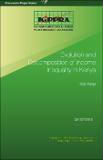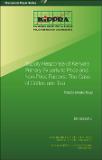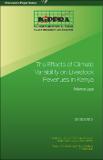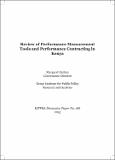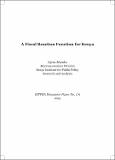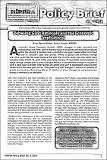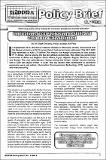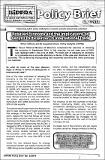3. KIPPRA Research Publications: Recent submissions
Now showing items 401-420 of 708
-
Policy Monitor, Issue 7 No. 2 January-June 2015 on Supremacy Wars Between State Agencies in Kenya Could Compromise Good Governance
(The Kenya Institute for Public Policy Research and Analysis (KIPPRA), 2015)Although each arm of government is independent of the other, the three are designed such that their functions complement and check on the excesses of the other. Good governance is compromised when either arm of ... -
Policy Monitor, Issue 6 No. 2, July-December 2015 on Role of Counties in Kenya's Trade Development
(The Kenya Institute for Public Policy Research and Analysis (KIPPRA), 2015)The lead article in this issue of the Policy Monitor discusses the dynamics of trade, especially in the new constitutional dispensation that saw the creation of counties. Being a critical factor in the country’s economic ... -
Kenya Economic Report 2015 on Empowering Youth through Decent and Productive Employment
(The Kenya Institute for Public Policy Research and Analysis (KIPPRA), 2015)The Kenya Economic Report (KER) 2015 is the seventh in a series of annual reports on the Kenyan economy prepared by the Kenya Institute for Public Policy Research and Analysis (KIPPA). Pursuant to KIPPA Act 2006, the ... -
Working Paper of 2015 on Fiscal Policy Scoping Study Kenya
(The Kenya Institute for Public Policy Research and Analysis (KIPPRA), 2015)A recent green economy assessment report (UNEP, 2014) on Kenya reveals that the transition to a green economy can deliver important benefits, such as long-term economic growth, a cleaner environment and high productivity. ... -
Discussion Paper No. 184 of 2015 on Enhancing Road Infrastructure Development through Public Private Partnership in Kenya: A Comparative Analysis
(The Kenya Institute for Public Policy Research and Analysis (KIPPRA), 2015)Infrastructure development offers the main platform for attainment of the development objectives envisioned in Kenya’s Vision 2030. Bridging Kenya’s infrastructure finance gap, which is estimated at US$ 2.1 billion ... -
Discussion Paper No. 175 of 2015 on Implications of Economic Partnership Agreements (EPAs) on Kenya
(The Kenya Institute for Public Policy Research and Analysis (KIPPRA), 2015)This study sought to examine the economic implication of EPAs on Kenya by analyzing trade relations between Kenya and EU, the implications of EPAs on regional trade and other trade arrangements, and the welfare effects on ... -
Discussion Paper No. 178 of 2015 on Barriers to Value Addition in "Omena" Fisheries Value Chain in Kenya
(The Kenya Institute for Public Policy Research and Analysis (KIPPRA), 2015)The purpose of this study was to identify barriers to value addition in “Omena” fisheries value chain and to analyze omena value addition for Suba sub-county in Homa Bay County. A barrier to value addition was defined as ... -
Discussion Paper No. 187 of 2015 on Evolution and Decomposition of Income Inequality in Kenya
(The Kenya Institute for Public Policy Research and Analysis (KIPPRA), 2015)This study traces the evolution of income inequality in Kenya and also decomposes income inequality. Various inequality measures are computed using the 1994 Welfare Monitoring Survey and the Kenya Integrated Household ... -
Discussion Paper No. 176 of 2015 on Access to Formal Finance: Constraints for Small and Medium Manufacturing Firms in Kenya
(The Kenya Institute for Public Policy Research and Analysis (KIPPRA), 2015)Small and Medium manufacturing firms are an integral sub-sector to the Kenyan economy. However, they have limited access to finance, which limits their growth. This paper examines the constraints of access to formal ... -
Discussion Paper No. 183 of 2015 on Supply Response of Kenya's Primary Exports to Price and Non-Price Factors: The Case of Coffee and Tea
(The Kenya Institute for Public Policy Research and Analysis (KIPPRA), 2015)This paper sought to empirically estimate the export supply response of coffee and tea in Kenya. The export supply models for both coffee and tea exports were developed and estimated using the Nerlovian technique. The paper ... -
Discussion Paper No. 182 of 2015 on the Effects of Climate Variability on Livestock Revenues in Kenya
(The Kenya Institute for Public Policy Research and Analysis (KIPPRA), 2015)This study examines the effects of climate variability on livestock in Kenya. It uses the Ricardian cross-sectional approach to measure the relationship between climate variability and revenue from livestock. Livestock ... -
Discussion Paper No. 186 of 2015 on Review of Performance Measurement Tools and Performance Contracting in Kenya
(The Kenya Institute for Public Policy Research and Analysis (KIPPRA), 2015)Performance measurement is crucial to the delivery of improved services in the public sector. The public contracting process in Kenya has been associated with innovativeness, effectiveness, efficiency, and quality services. ... -
Discussion Paper No. 185 of 2015 on Reduction of Carbon Emissions in Kenya: Focus on Renewable Energy
(The Kenya Institute for Public Policy Research and Analysis (KIPPRA), 2015)The country’s development blueprint Kenya Vision 2030 identifies energy as a key driver of the economy. However, the sector remains a high contributor of carbon dioxide emissions. This study examines the effect of using ... -
Discussion Paper No. 177 of 2015 on Towards a Coordinated Security Approach between Private Security Firms and the Police Service in Kenya
(The Kenya Institute for Public Policy Research and Analysis (KIPPRA), 2015)Insecurity in Kenya has increased due to rising crime incidents and terror attacks. In response, the government has centred on, amongst other measures, additional police recruitment in an effort to increase the number ... -
Discussion Paper No. 181 of 2015 on Efficiency of Fish Farming under Economic Stimulus Programme in Kenya
(The Kenya Institute for Public Policy Research and Analysis (KIPPRA), 2015)Fish is very important for food and nutrition security throughout the world. However, fish stocks from the natural sources in Kenya have been declining, making fish farming the only viable option to supplement fish supply. ... -
Discussion Paper No. 179 of 2015 on A Fiscal Reaction Function for Kenya
(The Kenya Institute for Public Policy Research and Analysis (KIPPRA), 2015)This study sought to determine whether Kenya’s fiscal policy is on a sustainable path by estimating a fiscal reaction function. A fiscal reaction function is a rule derived from an inter-temporal government budget ... -
Discussion Paper No. 180 of 2015 on Kenya and the East Africa Monetary Union
(The Kenya Institute for Public Policy Research and Analysis (KIPPRA), 2015)Kenya and other EAC member states are in the process of forming an EAC Monetary Union. Like other regional blocs with similar arrangement, the EAC has put in place macroeconomic convergence criteria. There are macroeconomic ... -
Policy Brief No. 01 of 2014 on Rebasing GDP: Rationale and the Economic Implications
(The Kenya Institute for Public Policy Research and Analysis, 2014)A country's Gross Domestic Product (GDP) changes in size, structure and composition over time. GDP is the total value of all goods and services produced within the country's borders over a period of one year, valued ... -
Policy Brief No. 04 of 2014 on Implications of GDP Rebasing on Skills and Professional Development
(The Kenya Institute for Public Policy Research and Analysis, 2014)n September 2014, the Kenya National Bureau of Statistics (KNBS) announced that the Kenya economy is 25.3% larger than it had earlier been estimated. The 2013 GDP was estimated at Ksh 4.76 trillion.This means that Kenya's ... -
Policy Brief No. 05 of 2014 on Rebased Economy and Implications on Kenya's Participation in International Trade
(The Kenya Institute for Public Policy Research and Analysis, 2014)he Kenya National Bureau of Statistics completed the exercise of rebasing the economy in September 2014. In this exercise, the old base year of 2001 was replaced with a new one of 2009. The main aim of rebasing an ...

